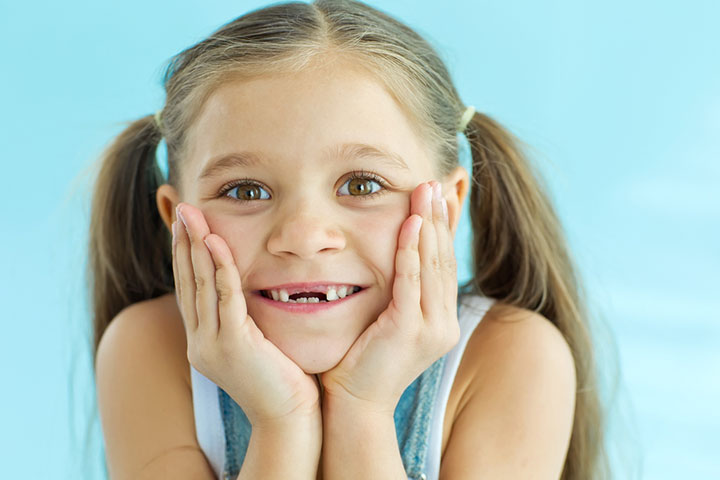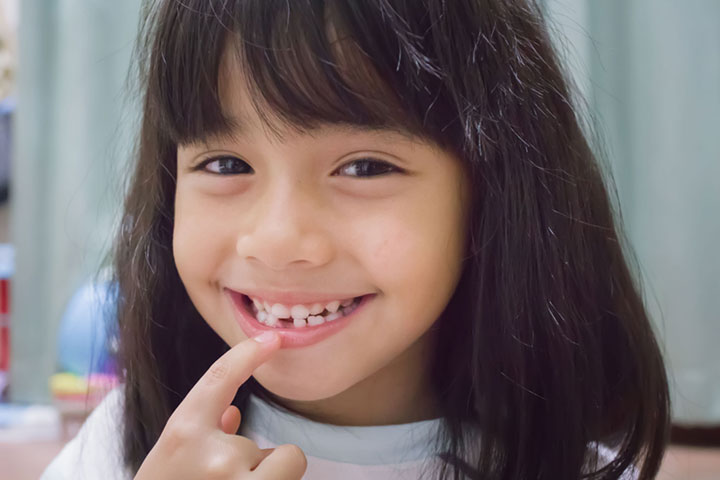
Image: Shutterstock
We all know that humans grow two sets of teeth in their lifetime. First, the milk teeth, and then the adult teeth that serve you for the rest of your life. By 6-8, most kids start losing their teeth one by one, and new sets of teeth take their place (1). And we know how adorable they look with their two teeth missing! A common misconception surrounding milk teeth is because they will fall out, you don’t need to take care of them. But wait till we tell you why you need to care for milk teeth the same even when you know they will fall off. There are numerous reasons to take care of your children’s gums and teeth, and because your child is still developing their motor skills, handing them their toothbrushes and expecting them to brush properly is not going to help. Here in this article, is why you need to brush your child’s milk teeth till they are old enough to do it themselves. Read on!
Why Milk Teeth Needs Special Attention
Milk teeth begin to appear between the age of 6-to-7 months, except for molars, which remain within the gums till about 11 to 12 years of age (2). While parents are aware that baby teeth serve as placeholders for adult teeth and play a vital role in nutrition absorption, they are frequently unaware that the health of baby teeth influences the condition of future permanent teeth. The study demonstrates that cavities in baby teeth triple the risk of caries in adult teeth (3). Thus, preventative care for baby teeth is essential. If milk teeth are not properly cared for, the accumulation of germs can lead to infections and cavities.
How To Pick The Ideal Brush For Your Toddler?
Typically, children under the age of five do not have the necessary motor abilities to correctly clean their teeth (4). Thus, it is essential to help them brush their teeth. And while doing so, use the proper approach. Parents must recognize that teeth are weaker and have less enamel, making them susceptible to tooth decay. You must use toothpaste with a potent anti-caries composition. If you’re concerned about artificial flavors, preservatives, colors, or sweeteners, you need to check on the label before purchasing the paste.
About the method, when brushing your child’s teeth, you should always stand behind them to reach the rear corners of their mouth. You may even clean your child’s teeth while they are seated on your lap. The steps involved in tooth brushing are as follows:
Step 1:
First, you need to start by wetting the bristles and then add a pea-sized amount of paste to the brush.
Step 2:
Hold the brush at a 45 ° angle against the gingival margin (the area where the gums and teeth meet). And gently rub the brush on their teeth.
Step 3:
Beginning at the gum line, brush lightly back and forth on the tooth’s chewing surface.
Step 4:
Using quick, sweeping movements, brush the exterior and inner surfaces of the teeth.
Step 5:
Tilt the toothbrush vertically and use gentle up-and-down strokes on the inside surface of the front teeth.
Step 6:
Now, concentrate on the side teeth. Lip the cheeks up and softly brush. You must slide the brush outward, inside, upward, and diagonally.
Step 7:
You need to brush for a minimum of two minutes morning and night, focusing on each individual tooth. Remember, this is when you form habits for your children so they should know that brushing is the first thing they need to do in the morning.
Step 8:
Gently brush the roof of the mouth and the tongue from back to front. Make sure you do it very gently as children are going to fidget all the way and you need to hold them tight to make sure they are out of harm’s way.
Step 9:
Now you need to teach your little one the concept of gargling and spitting. Little ones cannot gargle properly, so you need to do it with them and show them how it’s done. Many kid videos help your kid learn how to brush properly. It will also make brushing fun for your little one.
So now that you know how to help your child maintain healthy oral hygiene, nothing can stop you from keeping their teeth healthy and strong. Children learn better when they see their parents and family do things together, so you can make brushing a family affair where you all brush your teeth together. You can help your child pick out their brush and as they grow up, they can even put on the paste on the brush on their own! So, what is your trick to making brushing fun for the kids? Let us know in the comments section!














